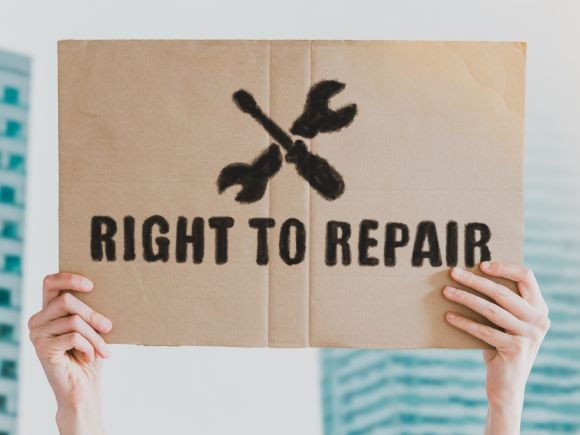This website uses cookies so that we can provide you with the best user experience possible. Cookie information is stored in your browser and performs functions such as recognising you when you return to our website and helping our team to understand which sections of the website you find most interesting and useful.
Cutting cost of repair is key to Right to Repair success

Euroconsumers and its members have long championed consumers’ right to repair their products. This seemingly simple ask – for easy, inexpensive and quick fixes for products that break down has proved very difficult to achieve.
Which is why the European Commission’s proposal on a new right to repair released in March of this year is so very important. But will it do the job?
The proposal is part of a package of measures covering the product lifecycle, including repairability score required by the Directive on Empowering the Consumers for the Green Transition, a clamp down on misleading claims about product durability in the Green Claims proposal, and the Ecodesign for Sustainable Products Regulation which stipulates requirements including product durability, reusability and reparability.
These wholesale changes to the entire consumer product cycle are needed to transition from a disposal culture to a clean, green, circular one. At the moment, it is cheaper and easier to dump and replace outdated or broken products and electronics than it is to fix them and keep them in use. While this remains the case, the incentives for manufacturers to build for long life simply won’t exist.
The current situation has resulted in a growing e-waste crisis and in consumers paying over and over again to replace their short-lived goods. New research has found that overall consumers have lost an estimated €12 billion per year by replacing instead repairing products.
Consumers want to repair products but it’s expensive and difficult
However, we know that 64% of consumers do try to repair their products but find it difficult.
And we know why – Euroconsumers’ research through the PROMPT project has identified the following factors for getting a repair: lack of knowledge, information and guidance; difficulty finding spare parts; low understanding of rights regarding legal guarantees and warranty periods; repair centres not being widely available; products being hard to open up to fix; software restrictions preventing diagnostics and repairs; but most importantly, because it’s too expensive.
Overcoming these barriers could see the birth of a new repair culture, but for this to take root all aspects need to be tackled at once. Below we look in more detail at the “Right to Repair” proposal and assess whether it will play its part in making repair and durability second nature.
What’s in Europe’s Right to Repair proposal?
The proposal is aimed at encouraging consumers to get repairs over replacements, building up the repair service sector, and incentivising manufacturers to minimize breakdowns and waste by making products that last longer and are easier to repair.
- Repairers will have to make much more comprehensive information on the costs and time of a repair available on a national, searchable online platform.
- A new voluntary European quality standard for repair services to drive up the quality and transparency of the sector.
- To shift to repair as a default, within the legal guarantee period, manufacturers will be required to offer consumers a repair over a replacement, unless it is more expensive. Currently a consumer can choose between a repair or replacement. In the short term, the repair costs of may remain higher than replacement costs, but the hope is that EcoDesign requirements will eventually make it cheaper to offer repairs.
- A new, ‘obligation to repair’ will fall on producers of particular goods even outside of the legal guarantee.
Failure to address high cost of repairs
While there are some welcome changes in the proposal, the critical issue of reducing repair costs has not been adequately addressed. This risks the right to repair remaining a pleasant idea on paper, not becoming realized in practice.
“Cost is the major barrier for consumers seeking repairs. If the proposal doesn’t put cost cutting front and centre the right to repair risks ending up to be a mere piece of paper” Els Bruggeman, Head of Policy and Enforcement, Euroconsumers
The cost of repair must be addressed much more directly in the proposal, by looking across the piece at all of the factors that make it up. Euroconsumers research insights as part of major, multi-stakeholder projects such as PROMPT and SHAREREPAIR show what could be done.
Extension of legal guarantee essential piece of the package
The new obligation to repair outside of a legal guarantee could certainly expand consumers’ options by making sure there is always a place to go if a product breaks down, but it will do little to cut the cost of repairs which is the major reason for not getting something fixed.
What would have been much better here for consumers would be an expansion of the legal guarantee period for more durable goods. This could include things like washing machines, TVs etc which Euroconsumers’ research found to be amongst those expensive items that frequently breakdown.
This would have shifted the incentives onto producers to make long lasting goods and remove one of the cost barriers for consumers.
Under the package, the current EU legal guarantee period remains at just two years, regardless of whether you’ve bought an electric toothbrush or a washing machine. This is clearly out of step with reasonable consumer expectations of how long an expensive household appliance should last.
Labour and spare parts drive up repair costs
Other factors that make up the cost are the price of spare parts and the time and therefore labour cost taken to unlock or access the product for repair – sometimes it can take half an hour to get a smartphone screen off, before you can even begin the repair!
We’d also like to see more attention given to the principles of ‘Design to repair’ which would include things like making quick access without specialist tools the norm, something that would cut costs. If principles like this were developed in parallel with the legislation, then availability of repair would be matched with cost-effective options.
US Right to Repair attempts to push down costs
There are also some developments worth monitoring in the US where over half of all states are pursuing or have passed Right to Repair style legislation in 2023. The EU has taken a pre-sale approach of incentivising durable and repairable design, and providing consumers with better information.
The US is seeking to stimulate competition in the after-sales market by establishing consumer and independent repairers rights to access to instruction manuals, software diagnostic tools, and more readily available spare parts.
Many of the bills stipulate that manufacturers should offer repair at “fair and reasonable terms”. Although it remains to be seen how this will work in practice, this might include making the cost of spare parts or tools the same for consumers as it is for repair professionals.
Consumers costs must fall for Right to Repair to become a reality
The very last thing consumers want is products that break down too fast – why on earth would they? And yet, this is too often the option shoppers are faced with, even when they invest in high ticket items like washing machines or TVs. They then face further high costs when those appliances and devices fail.
The Right to Repair and related proposals seem to directly address many of the aspects of the un-fixable and un-durable product system, but we are disappointed that so little has been done to address the critical factor of cost and longer guarantees.
Euroconsumers are concerned that unless more is done to lower costs and extend legal guarantee periods, the impact in practice will be minimal. Fix this and we can fix the broken product system.


